This column is about
my journey in learning to spin without wool
or any other 4-legged animal fiber, using the
same tools as everyone else.

So it seems I went away.
Not on purpose. Not as a result
of any grand plan, but because I was in way over
my head. And I'm not talking about how high the
yarn is piled in my office.
When last we spoke in this
column, it was about the purchase
of my first spinning wheel.
And then I went suspiciously silent. What happened?
Several things.
First, let's look at what I
was able to spin on the Joy with a few basic
lessons from some kind spinner friends:
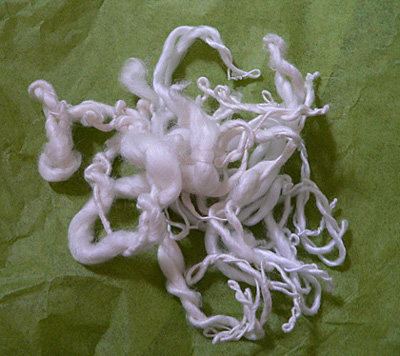
That is what can legitimately
be called soy fiber Yarn Barf, and it's the best
I could do, no matter how patient my teachers
were with me or how much I practiced. Enduring
the constant wheel stoppage because my too-thin
yarn broke or I hadn't put in enough twist and
it all pulled apart was really discouraging.
And then there was the tick.
I didn't notice the tick of
the wheel [one audible "tick" for each revolution
of the wheel itself] until I was spinning with
some friends. Jen also has a Joy, and hers was
blissfully silent. But mine annoyingly ticked
with each revolution, and it was just another
thing holding me back from getting into the spinning
groove.
Jen's husband, Jason, came
to my rescue that night. It involved a hammer,
a heavy set of pliers and loud banging noises
of metal against metal. When he was done, my
Joy was silent too! [It seems the little very-rigid
metal bar that joins the footmen to each other
was slightly bent in the wrong direction and
was making contact where it shouldn't have been.
He fixed it and I haven't had a problem since.
Lesson learned: A spinning
wheel isn't made of porcelain. It's a tool and
it needs to function as expected. A quick visual
inspection of the wheel and the tick showed
Jason what was rubbing against what, and it
was a simple, if loud, fix. Be brave and embrace
the hammer and pliers if that's what you need
to do!
So I should have been
spinning better and better yarn after that,
right? No. I was so mentally stuck in the "I'm
just not getting this" groove
that I couldn't shake myself out. When you're
surrounded by spinners doing what you want to
do – seemingly effortlessly – and
you're making little to no progress, it's hard
to keep yourself motivated. It didn't matter
that they were spinning wool and I couldn't.
I just wasn't getting any better and I was losing
patience, and worse -- motivation.
I was at a loss about how to get myself out
of this rut, until the brochure for SOAR [Interweave
Press' Spin Off Autumn Retreat] came across my
desk. My solution was staring me in the face:
Maggie Casey -- Spinning 101: Learn to
Spin or Refresh Your Skills
Maggie Casey – the
woman who taught Jillian [the editor of Knittyspin]
how to spin? Really? A three-day workshop just
to learn to spin? Perfect! I read further.
"… If you have always wanted to
spin, have taught yourself a little, or haven’t
spun for awhile, this workshop will be just
what you need to gain confidence and skill.
We will start with a beautiful
fleece, learn
to card, spin, ply, and set the twist. Then
we will spin woolen and worsted yarns, some
commercially prepared fibers and discuss wheel
maintenance."
| *My
fibers: cotton, hemp, linen, silk, soy,
bamboo, corn, milk or anything else that
never grew out of the skin of an animal.
I'm allergic to wool and sensitive to the
tiny barbs on all animal fibers, so I just
don't use any of it, in spinning or knitting. |
Oh, crap. Almost every
detail is just what I need, except that the
class is based on using wool. I am, as usual
when it comes to spinning, out of luck. I call
Jillian. "I want to
take Maggie Casey's workshop at SOAR, but it's
all wool-based." Jillian laughs. "Call
Maggie. Ask her if she'll do it with your fibers*." I
hesitate. Call the teacher? The legendary Maggie
Casey? Ask her to accommodate my specific
fiber limitations in a class full of [probably]
wool lovers? "Do it," Jillian said,
rather forcefully.
So I did. Maggie was
not only sweet and friendly, she was encouraging
and enthusiastic. "Sure!" she
said. "We can do it with your fibers."
Lesson
learned: you get nowhere in life without asking.
Ask, especially if you are
non-woolly like me and want to participate in
the usually woolly spinning world. You'd be surprised
at how many instructors are willing to accommodate
you!
And
so it was arranged. I was going to SOAR, the
legendary fiber retreat, to learn how to spin
once and for all.
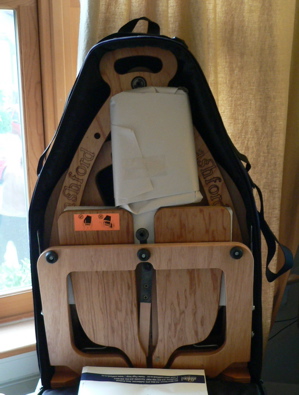  How do I describe SOAR?
It's spinning camp for adults. It's 3-6 days
of intensive learning, plus at least one day
of intensive and pleasurable fiber shopping.
It's a retreat, a workshop, a break from reality.
It's where old friends meet each year, and new
friends are made. Really, camp for adults, courtesy
of Interweave Press [the people who organize
it every year] and your own bank account [it's
not an inexpensive excursion]. How do I describe SOAR?
It's spinning camp for adults. It's 3-6 days
of intensive learning, plus at least one day
of intensive and pleasurable fiber shopping.
It's a retreat, a workshop, a break from reality.
It's where old friends meet each year, and new
friends are made. Really, camp for adults, courtesy
of Interweave Press [the people who organize
it every year] and your own bank account [it's
not an inexpensive excursion].
The first three
days are the Workshop – three dedicated
days with one mentor on one subject. The last
two are the Retreat [two sessions a day with
any of a selection of Mentors on a variety of
fiber-related subjects]. In the middle, there's
the big market day where spinners stock up on
fiber and tools for the season to come.
So in early October, I packed
the Ashford
Joy in the carry case [that's it
<-- over there on the left, tidily folded up
for travel] and was off to learn with the cool
kids. For those who wonder -- and I was one of
them until this trip -- the
Joy fits easily in any airplane's overhead
compartment, even a tiny 3-seat-across Embraer
jet. It was a real relief to be able to carry
my wheel with me, knowing it wouldn't get lost
or damaged in transit unless I was a doof and
dropped it.
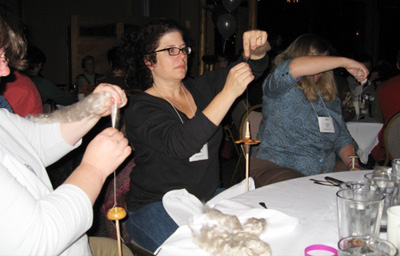  Rather
than give you a recap of my entire trip, let's
just say that the social aspects of SOAR were
everything I could have hoped for. It was a serious
blast and I had an amazing time. How could I
not enjoy myself at a place where it's socially
acceptable -- encouraged, even -- to spindle
while waiting for dinner to be served? Everyone
over there on the right -->
looks all serious, but I think we were
all just concentrating really hard so we wouldn't
waste the roving. Especially since we were at
a cocktail/dinner reception, and the first round
of beverages had already been toasted with. Rather
than give you a recap of my entire trip, let's
just say that the social aspects of SOAR were
everything I could have hoped for. It was a serious
blast and I had an amazing time. How could I
not enjoy myself at a place where it's socially
acceptable -- encouraged, even -- to spindle
while waiting for dinner to be served? Everyone
over there on the right -->
looks all serious, but I think we were
all just concentrating really hard so we wouldn't
waste the roving. Especially since we were at
a cocktail/dinner reception, and the first round
of beverages had already been toasted with.
But the reason I went was to
learn how to spin, so how did that go?
On the first day, we walked
into a hotel suite and took our place in a big
circle, our wheels in front of us. Maggie introduced
herself and passed out the handouts. And then
she pulled out a huge, sexy charcoal fleece.
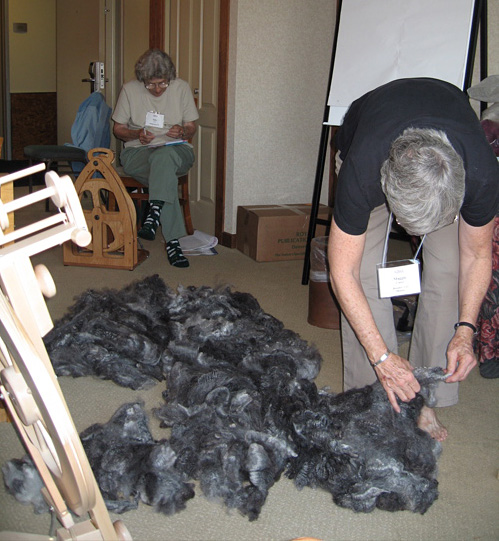
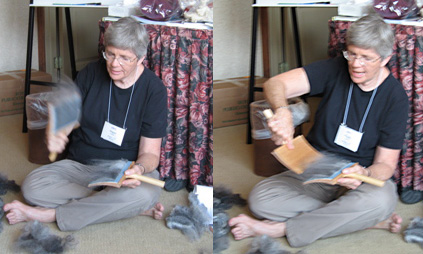  I smiled and pulled out
my knitting. I knew that not everything in class
could apply to me, and I was happy to listen
and learn. Maggie talked about sheep breeds
and wool and fleece and other things, and then
she got to carding. I smiled and pulled out
my knitting. I knew that not everything in class
could apply to me, and I was happy to listen
and learn. Maggie talked about sheep breeds
and wool and fleece and other things, and then
she got to carding.
Everyone grabbed a big hunk
of fleece and got to work. Maggie handed me…hemp.
Seriously. Hemp? My first fiber to learn to
spin is hemp? Okay, then.
I took the handcards
that Maggie offered – the
same tooth density as wool cards – and
began to imitate what everyone else was doing,
except instead of soft fluff, I was loading my
hand cards with crazy stiff plant material. I
surprised myself by turning off the normal skepticism
neurons in my brain; I was there, Maggie was
the expert and I was going to learn
whatever she could teach me. I kept my mouth
shut [uncharacteristically], listened and
watched intently.
I mimicked
the rocking motion Maggie was teaching us and…it
started to work. What I was creating was enough
like what everyone else was making that I could
follow along with them and keep up. As everyone
made woolly rolags, I made hempy ones.
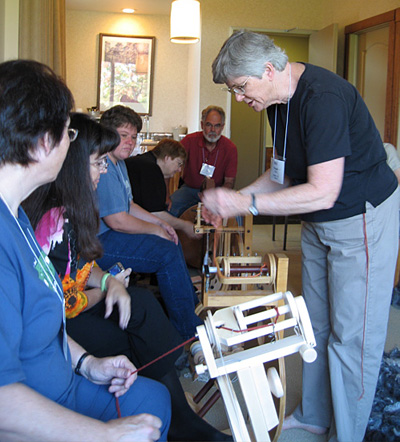
Then
Maggie got us all set up to spin. She made sure
our leaders were suitable, and showed us how
to attach them to the bobbins in a special way
that wouldn't come loose when
it was time to spin. Extremely cool. Everyone
else used, of course, wool. I used a two-ply
linen cord that Maggie gave me, and found it
fabulously grippy and an excellent choice. She
made sure our wheels were all correctly set --
because "it's always the wheel's fault" when
a new spinner can't make yarn.
Then we began
to spin, woolen, from our rolags. I watched everyone
else go first, seeing how they did it and trying
to get the motions in my head. Then it was my
turn. And it worked. I was able to spin
hemp woolen [softly, with lots of air in it].
It felt like a miracle. Sure, it wasn't truly
soft yarn, but I was spinning just like everyone
else in the room! The yarn wasn't breaking every
two seconds. I was filling a bobbin!
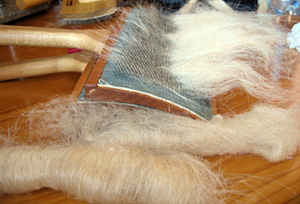  While
Maggie went around the room helping those who
needed it, I tried something. First,
I loaded the carder evenly with a little less
hemp than the first time. Then I added pure white
bamboo roving evenly over the top of the hemp
-->. While
Maggie went around the room helping those who
needed it, I tried something. First,
I loaded the carder evenly with a little less
hemp than the first time. Then I added pure white
bamboo roving evenly over the top of the hemp
-->.
When
I carded the two very different fibers together,
I was pleased to see that the sheen of the bamboo
evened out and softened the hemp, and the hemp
had enough tooth to keep the bamboo from slipping
off the carder's teeth. A few moments later,
I had a hemp/bamboo rolag.
Rather than agonizing
over how it would spin [would it spin at all?],
I just went for it. It spun. It was working!
Once again, the bamboo's smoothness made the
rough hemp more enjoyable to spin, the the hemp
kept the bamboo from being a slippery mess. I
was making yarn. Maggie came over
to see what I was doing, examined my work and
gave her approval.
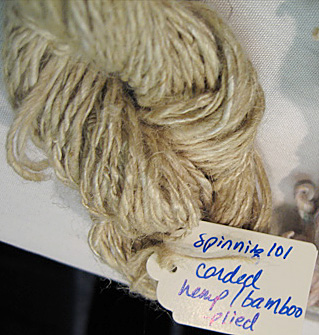  I
spent the rest of the day making rolag after
rolag of hemp/bamboo, and then spinning them,
marveling at what I'd learned on just this first
day and feeling encouraged for the first time
in my very short spinning history. By mid-afternoon,
I'd filled a good portion of two bobbins and
then it was time to ply. Maggie showed us how
and then it was our turn. My hemp/bamboo yarn
plied <-- pretty evenly, especially for a beginner.
I couldn't stop smiling. I
spent the rest of the day making rolag after
rolag of hemp/bamboo, and then spinning them,
marveling at what I'd learned on just this first
day and feeling encouraged for the first time
in my very short spinning history. By mid-afternoon,
I'd filled a good portion of two bobbins and
then it was time to ply. Maggie showed us how
and then it was our turn. My hemp/bamboo yarn
plied <-- pretty evenly, especially for a beginner.
I couldn't stop smiling.
That night, before I fell asleep, I imagined
the different things I could card together and
what they might look like.
Day two arrived and, let's
be honest, I was sore all over. A full day of
spinning is hard on anybody's body, and mine
was suffering. My hands ached, my back hurt and
I wasn't sure I'd survive the day. But within
an hour of the beginning of class, I had forgotten
all that and was into it again with a happy vengeance.
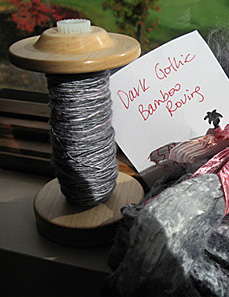  We
soon moved to worsted spinning, which, I learned,
was what I'd been sort of doing on my own
with all the slippery fibers I was trying to
spin -- bamboo, soy, silk. It
was a quick transition to worsted spinning for
me after Maggie's thorough lesson the
day before. I was happy to see that the breaking
and stopping wasn't happening nearly as often
as it had before. We
soon moved to worsted spinning, which, I learned,
was what I'd been sort of doing on my own
with all the slippery fibers I was trying to
spin -- bamboo, soy, silk. It
was a quick transition to worsted spinning for
me after Maggie's thorough lesson the
day before. I was happy to see that the breaking
and stopping wasn't happening nearly as often
as it had before.
By
the end of the day, I'd spun up 5.5 ounces of
deep grey bamboo roving into a rather nice worsted
single. My singles now had a lot less overspinny
twisties than before and way fewer thick parts
with not enough spin.
I let the twist sit on
the bobbin overnight and Navajo plied it the
next morning. It was thick, shimmery, 3-ply bamboo
yarn, just like I'd wanted to spin. Not perfect
yarn, but absolutely, unequivocally yarn and
definitely knittable. That night, my friend Carla
taught me to Andean ply, and this time, it stuck.
I started madly plying off all the hanky singles
I'd ever spun and just staring at the
little 2-ply hanks I was producing.
  After
that, something clicked on in my brain. I finally
gave myself permission to call myself a spinner.
No more qualifying adjectives or apologies. I
was just a new spinner, like every other new
spinner, with a learning curve ahead of me, but
no longer an insurmountable one. I was giddy
with the possibilities. After
that, something clicked on in my brain. I finally
gave myself permission to call myself a spinner.
No more qualifying adjectives or apologies. I
was just a new spinner, like every other new
spinner, with a learning curve ahead of me, but
no longer an insurmountable one. I was giddy
with the possibilities.
I walked around SOAR
with my handspindle and a bag of silk hankies
and spun and Andean plied like mad. I could be
spotted in the halls wearing a halo of whatever
I'd just spun resting happily on my head. Those
<-- are some silk hankies I'd bought on SOAR
market day and just spun and plied up the final
evening's Spin-In party.
Below you see my idol, Maggie
Casey, talking with me about the hankies I've
just plied [they're in that clear tube I'm holding]
and watching me beam with joy because she's helped
me become, in just three days, what all my friends
are.
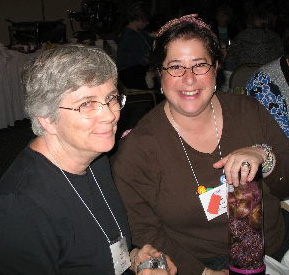  I
am a spinner, too. I
am a spinner, too.
Postscript: It's a
month and a half later, and I'm still spinning
like mad on my handspindle, and have continued
to work on my wheel spinning. My wheel-spun bamboo
is getting better all the time.
Two other unexpected things
resulted from my trip to SOAR:
1. a recurrence of my formerly dormant carpal
tunnel syndrome. It seems I was holding my fiber
not too tightly, but at too severe an angle for
my right wrist not to complain. Rest and following
my doctor's instructions have made this much, much
better since I returned home.
Lesson learned:
take care of your body, especially in such an intense
learning environment.
2. a new wheel. The spinner's
market was about more than fiber. A large number
of wheel manufacturers were there with wheels
for us to try. I manged to resist until the
very last afternoon, when I was firmly urged
to try the new Schacht
Ladybug wheel. Once I got
over that weird thing that new spinners have
about being watched, I got into my groove and
fell in love with the Ladybug and placed an order.
Lesson learned: if you are easily tempted,
never spin on another wheel unless your wallet
is prepared to deal with the consequences.
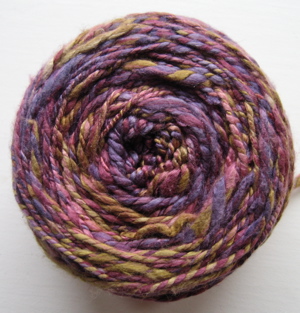  So
now I have two wheels to talk about in this column,
both very different from the other. I'll have
more pictures of the yarn I'm spinning and more
Ashford and Schacht wheel talk in the next issue. So
now I have two wheels to talk about in this column,
both very different from the other. I'll have
more pictures of the yarn I'm spinning and more
Ashford and Schacht wheel talk in the next issue.
But since I made you look at
my yarn barf, I should at least leave you with
something a little prettier. This is more than
100 yards of 2-ply bulky silk, spindle-spun from
hankies dyed by Nancy
Finn of Chasing Rainbows [colorway:
pansies].
If you'd like to take lessons
from the wonderful Maggie Casey, you'll find
her at Shuttles,
Spindles & Skeins in Boulder,
Colorado. |

